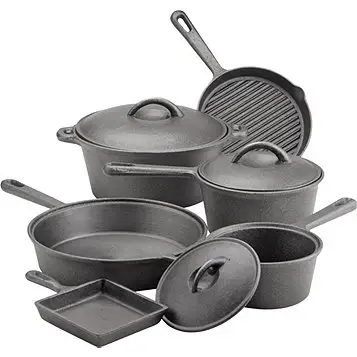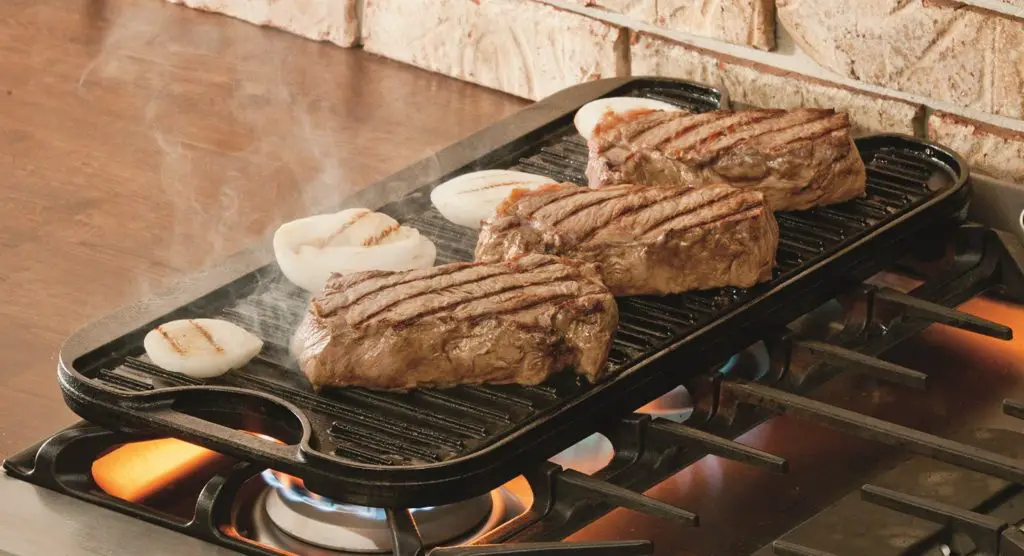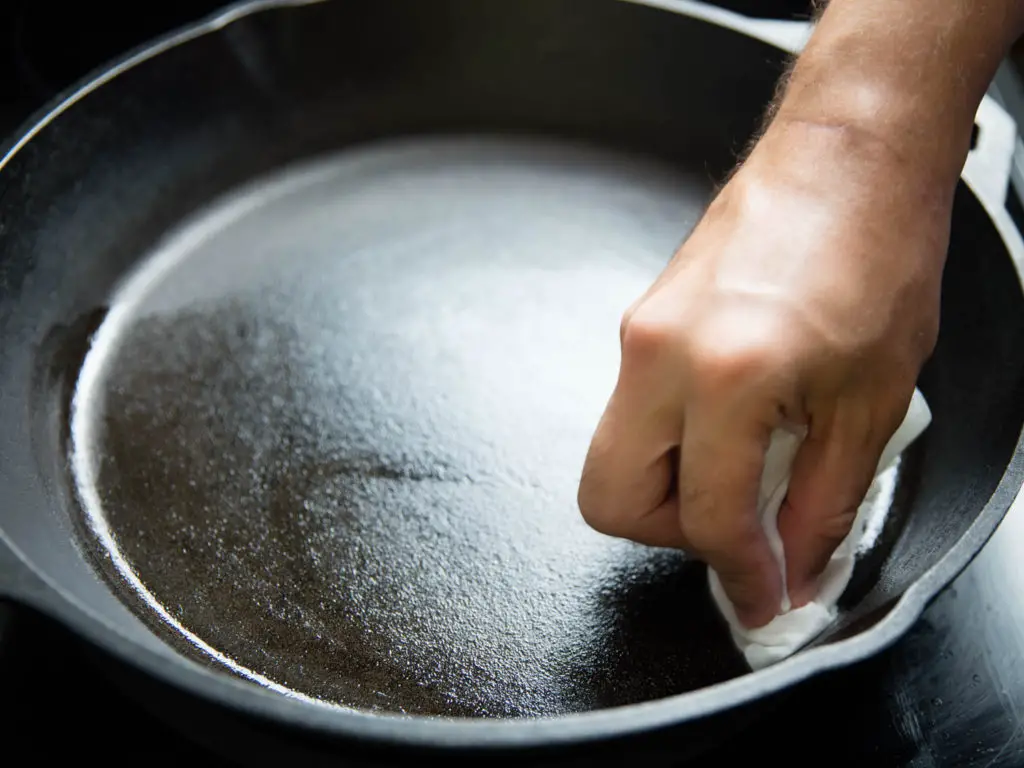 There’s a load of misinformation when it comes to cast iron pans. On the one hand there are people who claim you’ve got to treat your cast iron cookware like a new born babe. And on the other hand, there are the macho types who treat their pans like space junk! In fact, in the world of cast iron, there are several unfounded, untested claims and it’s time to put a few of those myths to rest.
There’s a load of misinformation when it comes to cast iron pans. On the one hand there are people who claim you’ve got to treat your cast iron cookware like a new born babe. And on the other hand, there are the macho types who treat their pans like space junk! In fact, in the world of cast iron, there are several unfounded, untested claims and it’s time to put a few of those myths to rest.
Myth #1: Cast iron is difficult to maintain.
The Theory: Cast iron is a material that can rust, chip, or crack easily. Buying a cast iron skillet is like adopting a puppy. You’re going to have to pamper it through the early stages of its life, and be gentle when you store it because that seasoning can chip off!
The Reality: Cast iron is tough as nails! There’s a reason why there are 75-year-old cast iron pans kicking around at yard sales and antique shops. The stuff is built to last and it’s very difficult to completely ruin it. Most new pans even come pre-seasoned, which means that the hard part is already done for you and you’re ready to start cooking right away.
And as for storing them? If your seasoning is built up in a nice thin, even layer like it should be, then don’t worry. It isn’t going to chip off. I store my regular non-stick frying pans with kitchen tissue between each to protect the non-stick coting. My cast iron pans are nested directly in each other and the seasoning is just fine.
Myth #2: Cast iron heats evenly.
The Theory: Searing steaks and frying potatoes requires high, even heat. Cast iron is great at searing steaks, so it must be great at heating evenly.
The Reality: Actually, cast iron is terrible at heating evenly. The thermal conductivity is around ⅓ to ¼ that of a material like aluminum. Which means that when you place a cast iron skillet on a burner, you end up forming very obvious hot spots right on top of where the flames are, while the rest of the pan remains relatively cool.
The real advantage of cast iron is that once it’s hot, it stays hot. This is vitally important when searing meat. To really heat cast iron evenly, place it over a burner and let it preheat for at least 5 minutes or so, rotating it every once in a while. Alternatively, heat it up in a hot oven for 10 to 15 minutes (but remember to use a oven gloves when you take it out)
The other advantage of cast iron is its high emissivity – that is, its tendency to expel a lot of heat energy from its surface in the form of radiation. You can put your hand close to stainless steel when it’s extremely hot and hardly feel a thing. Only the food directly in contact with it is getting any significant heat.
When you are cooking on cast iron, you’re not just cooking the surface in contact with the metal, you’re also cooking a good deal of food further away as well. This makes it ideal for things like making hash or pan roasting chicken and vegetables.
Myth #3: A well-seasoned cast iron pan is totally non-stick.
The Theory: The better you season your cast iron, the more non-stick it becomes. Perfectly well-seasoned cast iron is perfectly non-stick.
The Reality: Your cast iron pan is nowhere near as non-stick as Teflon, a material so non-stick that they had to develop new technologies just to get it to bond to the pan. Can you dump a load of cold eggs into your cast iron pan, slowly heat it up with no oil, then slide those cooked eggs right back out without a spot left behind? Because you can do that with Teflon-coated kitchenware.
That said, as long as your cast iron pan is well seasoned and you make sure to pre-heat it well before adding any food, you shouldn’t have too many problems with sticking.
Myth #4: You should never wash a cast iron pan with soap.
 The Theory: Seasoning is a thin layer of oil that coats the inside of your skillet. Soap is designed to remove oil, therefore soap will damage your seasoning.
The Theory: Seasoning is a thin layer of oil that coats the inside of your skillet. Soap is designed to remove oil, therefore soap will damage your seasoning.
The Reality: Seasoning is actually not a thin layer of oil, it’s a thin layer of polymerized oil, a key distinction. In a properly seasoned cast iron pan, one that has been rubbed with oil and heated repeatedly, the oil has already broken down into a plastic-like substance that has bonded to the surface of the metal. This is what gives well-seasoned cast iron its non-stick properties and, as the material is no longer actually an oil, soap should not affect it. Go ahead and soap it and scrub it.
The one thing you should avoid is letting it soak in the sink. Try to minimize the time it takes from when you start cleaning to when you dry and re-season your pan. If that means letting it sit on the stovetop until dinner is done, so be it.
Myth #5: Don’t use metal utensils on a cast iron pan.
The Theory: The seasoning in cast iron pans is delicate and can easily flake out or chip if you use metal. Stick to wood or nylon utensils.
The Reality: The seasoning in cast iron is actually remarkably resilient. It’s not just stuck to the surface; it’s chemically bonded to the metal. Scrape away with a metal spatula and unless you’re actually gouging out the surface of the metal, you should be able to continue cooking in it with no issue.
If you occasionally see flakes of black stuff chip out of the pan as you cook in it, it’s possible that it’s seasoning, but most unlikely. More likely, those flakes of black stuff are carbonized bits of food that were stuck to the surface of the pan because you refused to scrub them out with soap last time you cooked.
Myth #6: Modern cast iron is just as good as old cast iron.
The Theory: Metal is metal, cast iron is cast iron, the new stuff is no different than the old cast iron pans from early 20th century that people cherish and rave over.
The Reality: The material may be the same, but the production methods have changed. In the old days, cast iron pans were produced by casting in sand-based moulds, then polishing the resulting pebbly surfaces until smooth. Vintage cast iron tends to have a satiny smooth finish. By the 1950s, as production scaled up and was streamlined, this final polishing step was dropped from the process. The result? Modern cast iron retains that slightly bumpy, pebbly surface.
But that difference is minor. As long as you’ve seasoned your pan properly, both vintage and modern cast iron should take on a nice non-stick surface. However, your modern cast iron will never be quite as non-stick as the vintage stuff.
Myth #7: Never cook acidic foods in cast iron.
The Theory: Acidic food can react with the metal, causing it to leech into your food, giving you an off-flavor with potential health risks.
The Reality: In a well-seasoned cast iron pan, the food in the pan should only be coming in contact with the layer of polymerized oil in the pan, not the metal itself. So in a perfect world, this should not be a problem. But none of us are perfect and neither are our pans. No matter how well you season, there’s still a good chance that there are spots of bare metal and these can indeed interact with acidic ingredients in your food.
For this reason, it’s a good idea to avoid long-simmered acidic things, particularly tomato sauce. On the other hand, a little acid is not going to hurt it. I deglaze my pan with wine after pan-roasting chicken all the time. A short simmer won’t harm your food, your pan, or your health in any way.
These are the only rules you need to know to have a successful lifelong relationship with your cast iron.
**** Season it when you get it. Even pre-seasoned cast iron can do with some extra protection. To season your pan, heat it up on the stovetop until its smoking hot, then rub a little oil into it and let it cool. Repeat this process a few times and you’re good to go.
**** Clean your pan thoroughly after each use by washing it with soap and water and scrubbing out any gunk or debris from the bottom. I use the scrubby side of a sponge for this.
 **** Re-season it. Rinse out any excess soap with water, then place the skillet over a burner set to high heat. When most of the water inside the skillet has dried out, add a half teaspoon of a neutral oil like vegetable, canola, flaxseed, or shortening. Rub it around with a paper towel. Continue heating the pan until it just starts to smoke then give it one more good rub. Let it cool and you’re done.
**** Re-season it. Rinse out any excess soap with water, then place the skillet over a burner set to high heat. When most of the water inside the skillet has dried out, add a half teaspoon of a neutral oil like vegetable, canola, flaxseed, or shortening. Rub it around with a paper towel. Continue heating the pan until it just starts to smoke then give it one more good rub. Let it cool and you’re done.
**** Fry and Sear in it. The best way to keep your seasoning maintained? Just use your pan a lot! The more you fry, sear, or bake in it, the better that seasoning will become.
**** Don’t let it stay wet. Water is the natural enemy of iron and letting even a drop of water sit in your pan when you put it away can lead to a rust spot. Not the end of the world, but rust will require a little scrubbing and reseasoning. I always dry out my pan with a paper towel and coat it with a tiny amount of oil before storage.
There now, was that so hard? Now get out there and start cooking!